Unlocking Automation`s Potential: Empowering Women in B2B Commerce
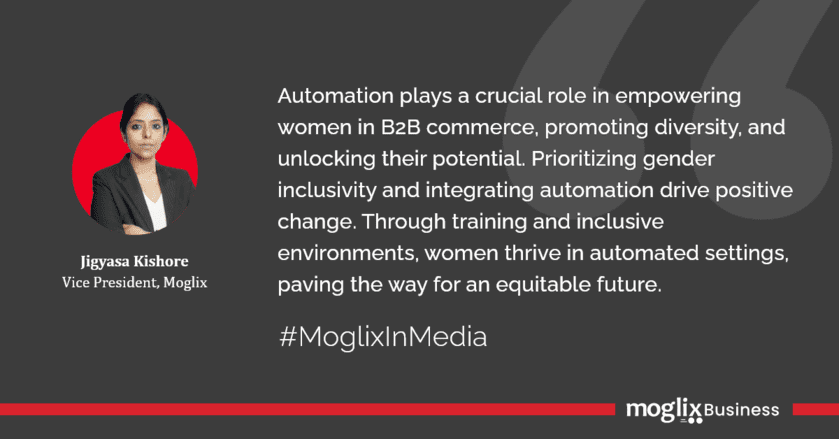
Unlocking Automation`s Potential: Empowering Women in B2B Commerce
Innovative technologies are shaping the future of B2B commerce automation. Women equipped with the appropriate skills can utilize automation tools to enrich their roles across various industries, especially in supply chain management. Automation not only provides avenues to enhance productivity but also promises ongoing transformation in B2B commerce, delivering heightened flexibility and efficiency. Central to this evolution will be the integration and automation of procurement processes.
Read MoreOutlook Business Spotlight- Indo Global Business Excellence Awards and Summit 2024
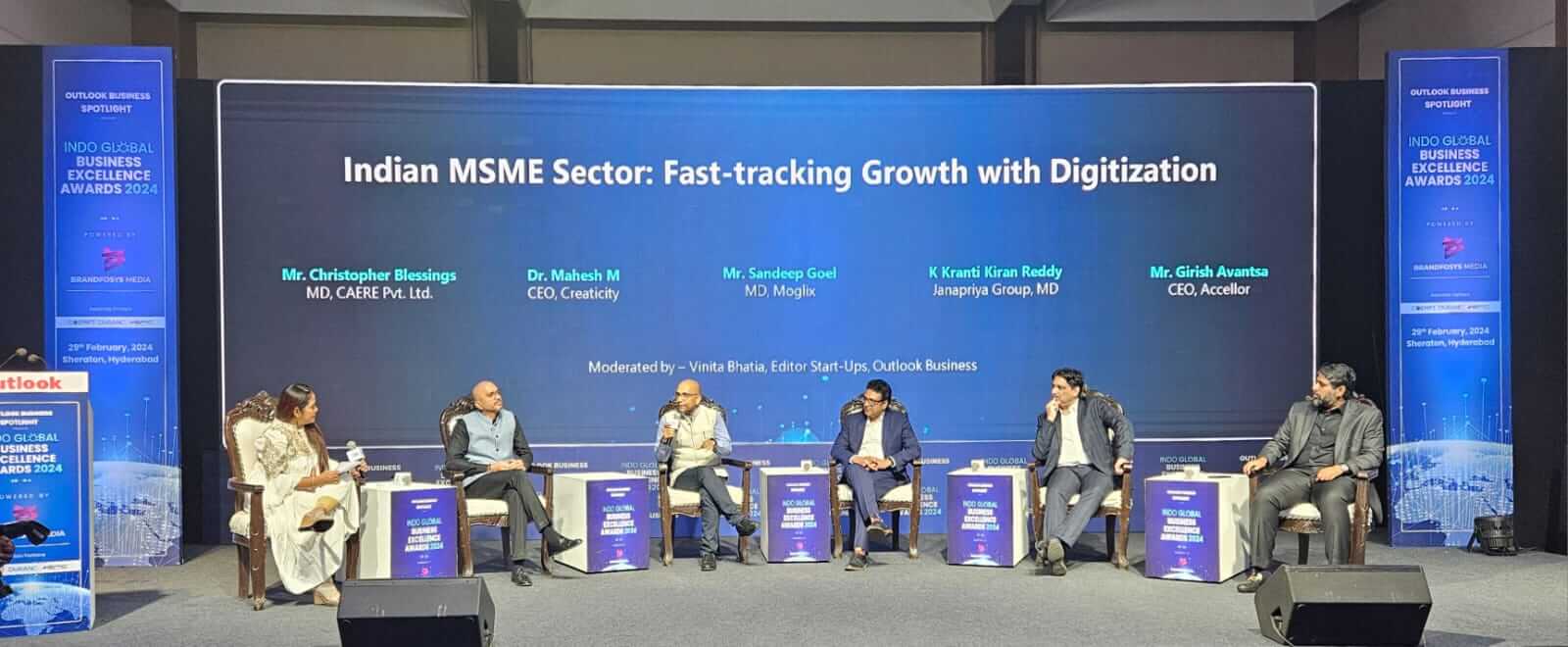
Outlook Business Spotlight- Indo Global Business Excellence Awards and Summit 2024
Date: February 29th , 2024
Organizer: Outlook
About the Event:Mr. Sandeep Goel, Managing Director, Moglix, shared his expertise on ‘Indian MSME Sector: Fast-tracking Growth with Digitization
Moglix aims to onboard 500 new professionals within the next 18 months
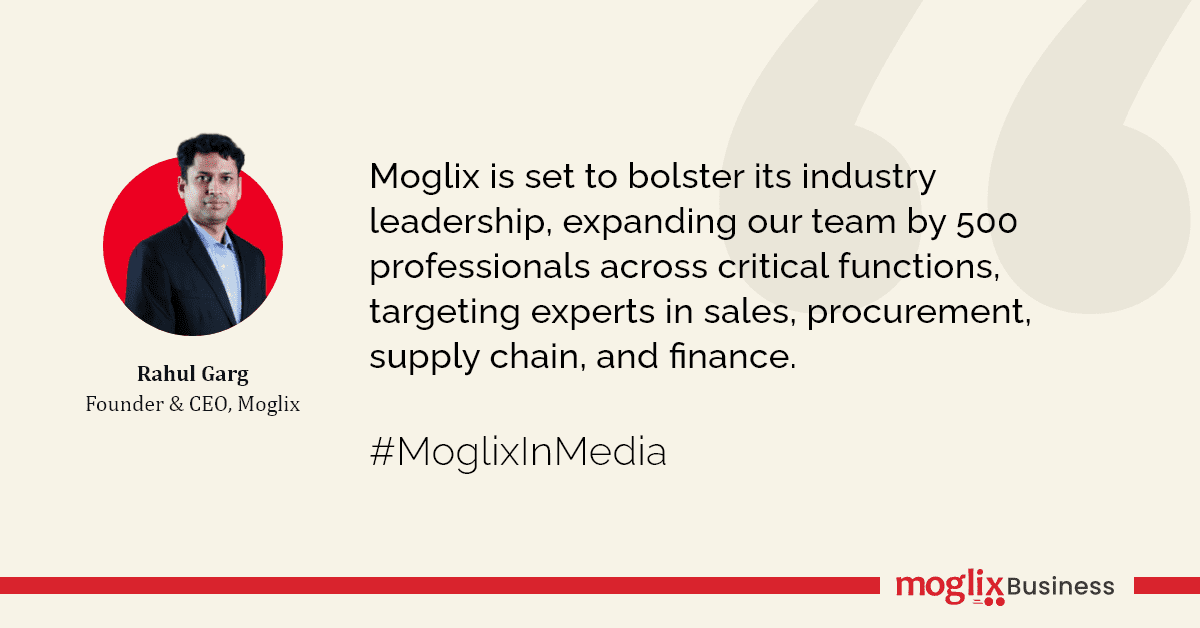
Moglix aims to onboard 500 new professionals within the next 18 months
Moglix is on the verge of significant expansion! Over the next 18 months, we’re set to onboard 500 new talents to solidify our standing as India’s premier B2B commerce platform. Join us in reshaping the landscape of B2B commerce and propelling growth in the manufacturing and infrastructure supply chain sectors.
Come be a part of our exhilarating journey of expansion and innovation!
Bharat Tex 2024

Bharat Tex 2024
Date: September 26th , 2024
Organizer: Messe Frankfurt
About the Event: Moglix fashion participated in the world’s largest textile fair and are delighted by the enthusiastic engagement from all the attendees.
Revolutionizing Garment Production: AI and Automation Transform the Future, Boosting Efficiency and Precision
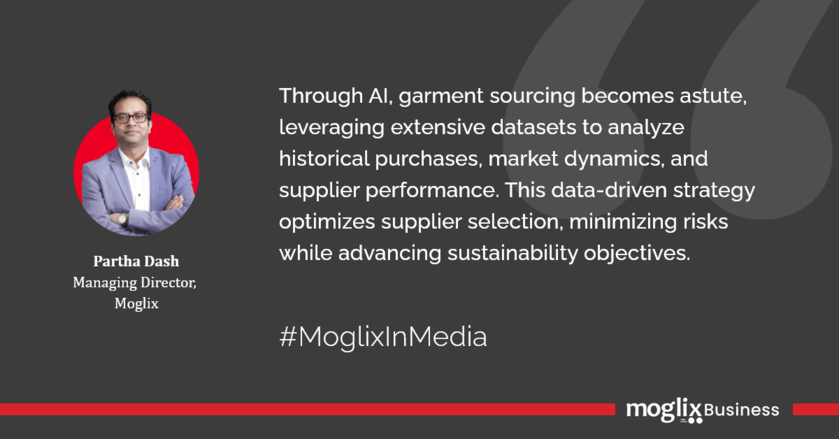
Revolutionizing Garment Production: AI and Automation Transform the Future, Boosting Efficiency and Precision
Manual garment production processes, long relied upon, come with inherent limitations. Tasks repetition leads to fatigue and errors, causing quality inconsistencies and missed deadlines. Supply chain bottlenecks frequently result in production delays, while procurement suffers from limited information and forecasting inaccuracies, driving inefficiencies. These challenges result in high costs, dissatisfied customers, and an industry struggling to adapt to market dynamics.
Read MoreStreamlining Procurement: The Power of P2P Automation

Streamlining Procurement: The Power of P2P Automation
As a Chief Procurement Officer, staying ahead with technology is crucial. P2P automation is a game-changer, breaking down old barriers in procurement. Gartner’s report shows a big move towards this, with the procure-to-pay market growing fast, expected to reach $13.4 billion by 2025. Automation can make your processes smoother, quicker, and more efficient. It’s all about making smart moves now to lead in the future.
This blog will explain how procure-to-pay software revitalizes your businesses, especially if you follow a traditional approach involving repetitive tasks.
The Evolution of P2P
The evolution of the Procure-to-Pay process has remained a contemplating point for CFOs and CPOs to increase efficiency and savings. The traditional manual procure-to-pay cycle, coupled with inefficiencies and poor spend visibility, contrasts starkly with the clarity and compliance of automation.
Moglix shows how a tire company could save money by changing how it does P2P. The company initially needed help with manual tasks and a need for unified suppliers. However, by automating P2P, they achieved a 3% cost decrease, a 95% OTIF rate, and a shorter PR-to-PO period of two days. This shows how efficient technology is, which is important for CFOs and CPOs who want to cut costs.
Navigating Challenges for Business Efficiency
A prominent EPC company’s MRO procurement process could have been more efficient due to a fragmented supplier base, inefficient multi-step processes, lack of standardized catalogs, and delayed order processing times. These challenges caused delivery delays, quality issues, and higher procurement prices. Moglix’s procurement workflow digitization helped solve these issues. Moglix implemented a streamlined procure-to-pay solution to improve procurement efficiency and transparency and reduce MRO procurement costs by 20%, proving that digital transformation can overcome operational challenges.
Final Words
When organizations upgrade their P2P method, they can cut costs, save time, get better visibility, and make mistakes less likely. Chief financial officers can learn more about how much money is being spent, which helps them control costs and negotiate better. Automation cuts down on manual chores by a large amount; A uniform system makes it easier to see what’s happening and make decisions. Automation in accounts payable lowers the chance of mistakes. In the end, P2P automation makes making requests easier, recording invoices, matching them, getting approval, and connecting them to ERP systems. This helps keep costs down, speeds up processing, and ensures correct financial reports.The procurement-to-pay process allows businesses to make wise decisions and enhance their financial operations. So, it is prudent for companies to proactively take consultations from experts like Moglix to learn more and resolve their supply chain issues.
Reference:
Red Sea Crisis Impact on Supply Chains: Key Info for CPOs
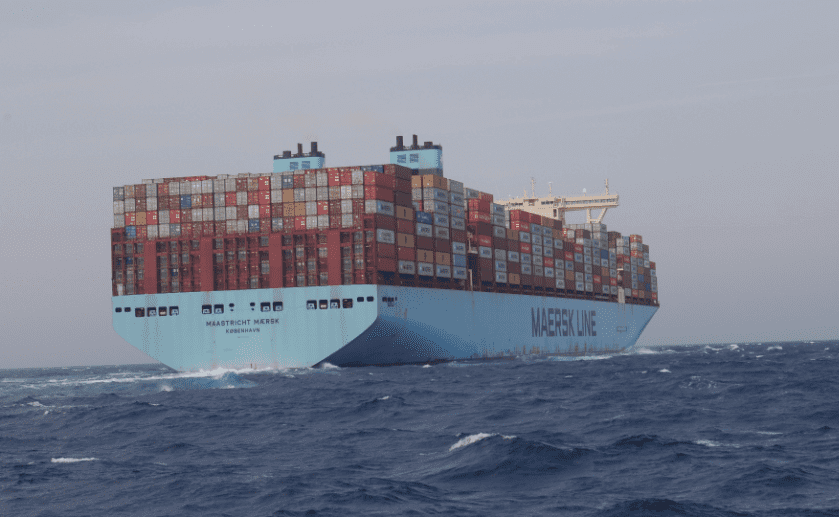
Red Sea Crisis Impact on Supply Chains: Key Info for CPOs
As stated by an official, the Red Sea crisis [1], sparked by Houthi rebels in November 2023, has severely disrupted global supply chains, particularly impacting Asia-Europe trade routes via the Suez Canal. According to UNCTAD, there’s been a 28% [2] decrease in daily canal transits in early January 2024, forcing reroutes that add significant costs and delays.
According to a Geopolitical Monitory research, this conflict skyrocketed shipping costs by 173% [3]. This alarming situation is a critical wake-up call for Chief Procurement Officers globally, emphasizing the urgent need for robust risk management and contingency planning in supply chain operations.
To mitigate global shocks, Chief Procurement Officers must focus on Strong supply chain management, risk analysis, planned route diversification, and quick response to enhance overall supply chain resilience.
The wake-up call
The crisis in the Red Sea is changing how we handle world trade and supply lines in big ways. Shipping charges amplify when routes have to be changed because of it. There are a lot of problems in fields that depend on buying and selling things across borders, like energy, technology, and car manufacturing. It’s important to have good supply chain plans to keep things going easily and drop risks. The main goals of these plans should be to get things from different places, better track of stock, and use various transport methods.
It has had a huge effect on the world economy. As per a Geopolitical Monitor study, the cost of shipping a 40-foot container from Asia to Northern Europe has risen by $4,000 [4]. Vessel insurance prices also increased: for a $100 million vessel, the cost increased from 0.1-0.2% to 0.5%, $300,000 to $400,000 [4]. This cost increase is putting inflationary strains on the region’s fragile economic recovery.
Especially in light of the Red Sea situation, Chief Procurement Officers (CPOs) need to understand how important transparency in the supply chain is. According to a study by Harvard Business Research, 90% [5] of leaders think being more open encourages employees to make more informed choices. Supply chain apps that use digital tools like blockchain and AI can better track and manage risks, which makes things simpler. Buyers and sellers need to speak clearly and regularly so that information can be shared and decisions can be made quickly. This way of doing things is important for improving businesses and dealing with tough global trade problems.
Another important lesson is how to outsource in the supply chain. This is what more than 80% of supply chain workers do when they want to raise the cost of outsourcing. Utilizing the expertise of outside delivery companies enables businesses to concentrate on their core operations.
Streamlining Complexity
A case study shows how important it is to have strong supply chain plans and clear communication between all parties involved: A tire manufacturer with seven plants struggles with supply chain issues, such as keeping track of more than 8,000 line items and 600 sources, which slows things down and wastes time. Even though these things went wrong, they could save 3% on their overall costs.
Final words
Finally, the Red Sea situation emphasizes the need for Chief Procurement Officers to engage in supply chain digital transformation. This transformation is critical for successful supply chain management, allowing organizations to negotiate complex global difficulties while increasing resilience. Adopting digital solutions in supply chain management services is critical for risk mitigation and operational efficiency. Explore professional insights and modernize your supply chain with Moglix. Delve into disruptive tactics and find comprehensive solutions to enhance your operations.Explore professional insights and modernize your supply chain by delving into disruptive tactics and discovering comprehensive solutions. For more information, turn to Moglix.
References:
- https://economictimes.indiatimes.com/red-sea-crisis-affect-on-indias-trade/articleshow/107402330.cms
- https://www.msn.com/en-in/news/India/red-sea-crisis-affect-on-indias-trade/ar-BB1hKnOA
- https://www.geopoliticalmonitor.com/red-sea-crisis-exposes-a-weak-point-of-global-maritime-trade/
- https://www.geopoliticalmonitor.com/red-sea-crisis-exposes-a-weak-point-of-global-maritime-trade/
- https://www.basware.com/en/resources/harvard-business-review-analytic-services-using-transparency-to-enhance-reputation-and-manage-business-risk
The Importance of Proper Foot Protection: A Guide to Safety Footwear

The Importance of Proper Foot Protection: A Guide to Safety Footwear
The Directorate General Factory Advice Service & Labour Institutes (DGFASLI) says that about 4,000 [1] injuries, including foot injuries, happen yearly, causing people to miss days at work. That’s why wearing the right shoes to protect your feet is important, just like other industrial safety equipment you use at work. Let’s learn about workplace dangers that can hurt your feet and the types of safety shoes you can buy.
Different Types of Workplace Hazards Involving Foot Injuries
Falling and Flying Objects
Sometimes, workers work in a dynamic work environment. It involves big vehicles, heights, or heavy machines. Here, shielding the feet against falling and flying objects becomes imperative.
Defense against punctures
The ground of a construction site is full of sharp objects. Regular soft-soled shoes may not be able to provide substantial protection. This might lead to punctures and foot injuries.
Cutting hazards
Industries into cutting or drilling operations involve machine parts with sharp turns or pointy edges, such as chainsaws and grinder cutters. Using them without protection gears might expose workers to significant foot and leg injuries.
Electrical Hazards
When live electric wire comes in contact with the ground without earthing protection, the working personnel will feel the electric shock without non-conductive footwear. Such shoes are also important to save workers from static electricity.
Slips, Trips, and Falls
More than 40% [2] of injuries at the workplace are due to slips, trips, and falls, out of which 16% of accidents involve falls on the ground level. It can happen due to poor lighting, trailing cables, uneven flooring, or cluttered walkways. Proper footwear with adequate traction to prevent foot and other injuries.
Burn and Fire Hazards
According to reports from OSHA, almost 200 [3] workplaces catch fire daily. Normal fire dangers, chemical spills, or hot, melted metals can cause these fires. Workers must wear strong, protective shoes in these kinds of workplaces to keep them safe.
Types of Safety Footwear
Industrial Safety Shoes
These are anti-slip, steel-reinforced shoes to offer protection in extreme working conditions such as construction, logistics, electronics, automobile chemicals, etc.
Work Boots
Work boots cover half calves to offer protection from electric shock, heat, fuel/oil spills, and sharp objects at the workplace.
Steel Toe Shoes
The toe box of such shoes is made of heavy-duty steel to offer maximum protection against puncture, compression, and impact in all weather conditions.
Electrical Safety Shoes
Electric safety shoes are made of non-conducting leather and non-metallic fiber toes with PU soles. They can resist high electric shocks of 11kv for up to one minute.
Leather Safety Shoes
Usually made of carbon steel, these shoes offer protection from impacts and can resist heat up to 300°C for one minute.
High Ankle Safety Shoes
These shoes come with durable protective material coupled with soft cushioning at the top to aid comfort and safety.
Waterproof Safety Shoes
Workers working under water-logged conditions need shoes to protect their feet from harsh chemical liquids, shocks, and chemicals.
Welding Shoes
These are breathable, anti-skid shoes with heat and burn-resistant features well suited for electric welding, leg welding, and blacksmithing spats.
End Thoughts
Choosing the right safety shoes requires identifying the hazard type and the ideal material that can offer the best protection. However, an expert consultation should not be an option to ensure maximum workplace safety.
The safety of your workers is more important than anything else. Ensure it by adopting the right safety equipment and safety rules in industry. Visit our website to learn more.
Reference:
Butterfly Valve 101: Here’s all you need to know
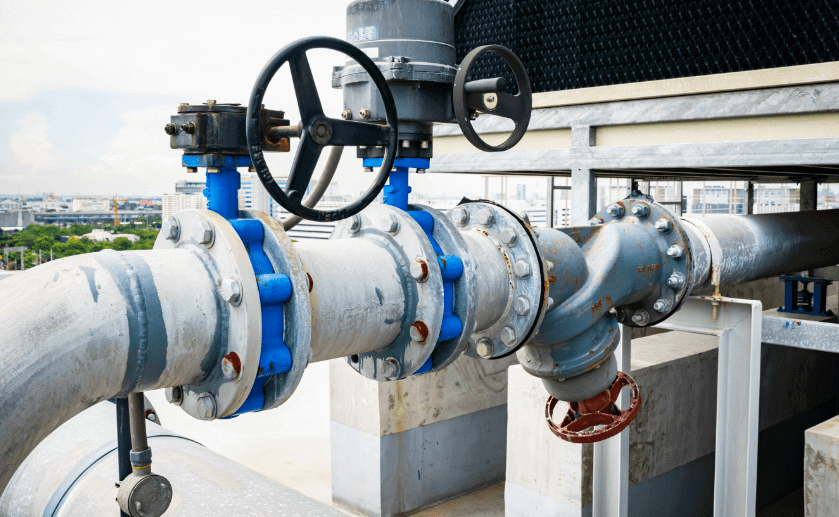
Butterfly Valve 101: Here’s all you need to know
According to the Butterfly Valve Market study, the worldwide market for butterfly valves is expected to grow to about 6860.09 million dollars [1] by 2028. Butterfly valves are liked because they control the flow of liquids or gases well. They don’t cause much pressure to drop and can handle much flow without much care, saving money. But these valves come in different sizes. You need to pick the right size and shape of a butterfly valve for what you need it for. You must also check it regularly to ensure it works safely and well. Let’s learn more about butterfly valves and get some tips from experts on keeping them working great.
Butterfly Valve Construction and Working Principle
Butterfly valves work by turning a quarter of a circle. They are really useful for either stopping or controlling the flow of liquids. Such BF valves comprise two offsets of the disc from the valve body’s center. Some major butterfly valve components are:
- Valve body
- Disc
- Seat
- Stem
- Seals
Butterfly Valve actuation
Here are four different ways to control the opening and closing of valve speed.
Manual: simple and inexpensive valve operations using a handwheel, crank, or lever to control the stem and the disc
Electric: four 20 mA control signals are used via a bi-directional motor for process control in non-critical and light-duty modulation activities.
Pneumatic: the valve is operated through a piston within a closed cylinder. These are useful for controlling highly flammable liquids like petrochemicals, Oil, and Gas.
Hydraulic: These actuators use pressurized oil instead of air. The aim is to achieve high control during valve operations.
Diverse usages of Butterfly Valve
Butterfly valves are used in various industries, such as:
- Fluid control in water supply, collection, distribution, and pumping stations
- Fluid control in the pharmaceutical, chemical, and food industry
- To control aggressive media involved in refineries at extreme temperatures and pressure
- Used for jack-up rigs, ballast systems, and firefighting apparatus in the ship-building
- Regulating and isolating the flow in power generation units
- Preventing backflow in some situations
Size considerations
Butterfly valves come in lots of different sizes. It can be a few inches or several feet. So, choosing the right size is important for the safe operation. Butterfly valves that follow ANSI, API, and ISO standards are good choices. They are reliable and high-quality, meeting safety, performance, and lasting use standards.
Picking the valve’s size depends on what you need it for. For example, the common sizes for big pipes in places like chemical plants or water treatment centers range from 2 inches to 96 inches. So, looking at the specifications to choose the right type, size, and valve dimensions is important.
Practical Usage Tips for Butterfly Valve
- Ensure the valve is correctly installed
- The flow direction should align with the arrow on the valve body.
- Perform periodic maintenance to check for wear and tear on the valve sealings.
- Operate the valve within the specified pressure and temperature limits.
- Do not tighten the valve too much as it may damage the seals and reduce its lasting.
- When used in a dusty environment or with corrosive materials, periodically clean the valve to ensure smooth operation.
Guarantee the safety and efficiency of your industry with premium butterfly valves from Moglix Solutions! To learn more, contact Moglix Business today!
Reference:
https://www.linkedin.com/pulse/butterfly-valve-market-size-2023-2030
Digital Transformation in Procurement: Navigating the Current Trends and Future Directions
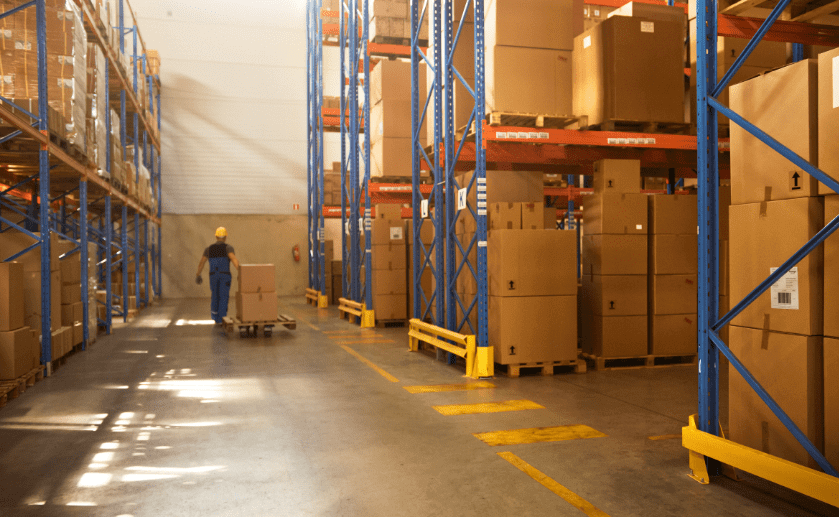
Digital Transformation in Procurement: Navigating the Current Trends and Future Directions
Recently, the business area that deals with buying things (procurement) has benefited from new technologies. According to a Zipido report 2023, almost 83% [1] of chief procurement officers believe it’s important. They feel it’s time to be super efficient, good at handling risks, and make smart choices to meet ever-changing customer demands. In this regard, in this article, let’s understand the popular trends and future of digital procurement transformation. We will learn the role of AI in making decisions, blockchain in integration, and other such innovative technologies. Let’s see how they help reshape procurement with ease.
Three Focus Areas in Digital Procurement Transformation
Use AI for Automation
As per the Harvard research, big companies like Walmart, Tyson Foods, and Koch Industries use a special computer program called AI (Artificial Intelligence) to help them handle their supply chain [2]. They use AI to automate a lot of tasks. It includes buying new items, searching and identifying new suppliers to work with, automatic negotiations, etc. This saves them a lot of time.
Instead of the old way of keeping track of what they have in their stores, these companies now use a new system that orders more stuff by itself when needed. This helps them ensure they only have a little or little of something. AI can also handle paying for things automatically when they are delivered, which saves time and means fewer people are needed to do these jobs.
Use Blockchain to Improve Supply Chain Visibility
The use of Blockchain in supply chain transformation is also increasing. According to the Industry Trends, Value, Analysis & Forecast Report by Zion Market Research, it may attain a growth of 51.3% [3] between 2022 and 2028. The technology offers a secure and tamper-proof platform to shield sensitive information. Some leading supply chain startups that use Blockchain like this are Yojee, Te-FooD, T-Mining, and SUKU.
This app lets everyone see what’s happening clearly. For example, businesses can write down their deals at different steps in their supply chain in a special kind of record book called a Blockchain ledger. They can also use AI (Artificial Intelligence) and IoT (Internet of Things). Then, the Blockchain can spot problems in getting supplies or sending products to the supply chain. This helps companies act quickly to reduce these risks in advance.
Utilize Big Data for Spend Analysis
Nearly 97% [4] of companies worldwide are using big data to get useful business information. The technology makes use of your expenditure information to offer useful advice. You can learn to easily predict profits, avoid mistakes, and identify new market opportunities. Many companies are already doing this to find areas of improvement in procurement. This saves companies from tiresome manual processes and paper-based workflows.
End Thoughts
Digital procurement is already a reality. Shifting the focus to supply chain digital transformation is improving the overall procurement efficiency. It also helps cut down manual intervention and save costs in procurement. Adhering to best practices and trends in e-procurement can help companies reap more benefits of digitization. Read our case study on how Moglix enabled automotive OEMs to unlock 2% cost savings in indirect procurement through supplier consolidation. For more information on procurement transformation, contact Moglix Business today!
